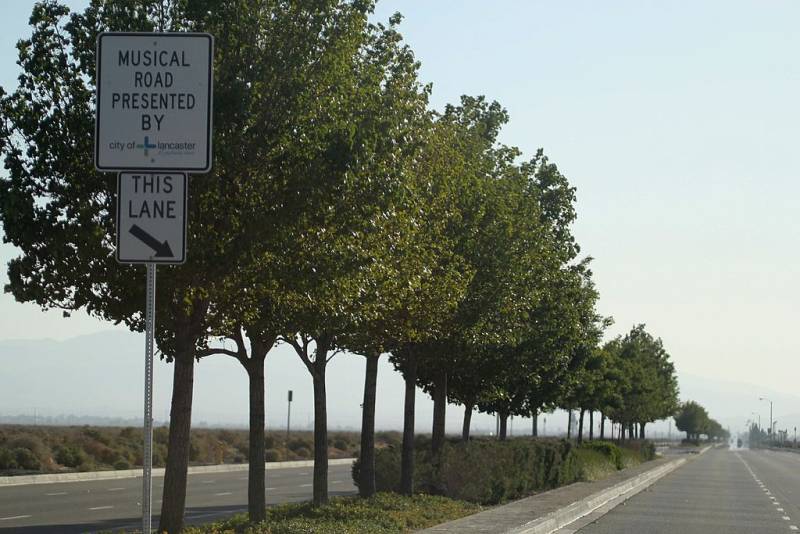Sandra is a waitress at Foxy’s Landing & Restaurant, that old-school diner.
“Back in 2011, when I moved out here with my friends, they took me on that road,” she said. “We went over it, and it was pretty cool.” Then she added, “I feel like we could have a little better tone.”
This novelty was built by the car company Honda back in 2008 as part of a TV commercial for the Civic.
At first, the distinctive sound didn’t go down well with some Lancaster residents. People who lived nearby said it was a scratchy sound, like a high-pitched drone or whining. One person said it was like an orchestra that’s constantly out of tune.
Honda originally built the road in a much more populated area on Avenue K in downtown Lancaster. However, according to news reports at the time, the noise complaints were so bad that the city spent $35,000 to remove and relocate the road to its current location outside of town.
How does it work?
Physicist David Simmons-Duffin remembers hearing the Honda commercial for the first time. He was in graduate school, home for the holidays, visiting his parents.
“I remember I was in my parents’ kitchen, and the commercial came on the TV,” he said. “I was intrigued because I’d had some experience with these rumble strips on the road before.”
The concept reminded Simmons-Duffin of a childhood memory.
“When I was a kid, we used to drive to a park in Canada. On the roads, they would have these rumble strips before the stop signs, and my dad would experiment with trying to play music by going different speeds over the rumble strips. We would talk about how fast we needed to go to make different kinds of musical scales. It didn’t come out right a lot of the time, but sometimes he got the timing just right, and then we would all cheer in the car.”
Years later, sitting in his parents’ kitchen watching Honda try to replicate the effect in their commercial, Simmons-Duffin was disappointed.
“It sounded so terrible,” he said.
Simmons-Duffin, who is now a professor at Caltech, decided to use his computer to make a simulation of the road.
“I was able to reproduce the terrible music from the commercial,” he said. “It was a neat challenge, using my own ears and a little bit of mathematics to do the detective work and figure out what had happened.”
The musical road works on a basic principle: as a car drives over grooves cut into the asphalt, it vibrates.
“There’s a very simple formula for the frequency that you get from the note when a car drives over a rumble strip,” Simmons-Duffin said. “It’s basically the velocity of the car divided by the distance between the grooves.”
So, in order to make a melody, the grooves in the road need to be precise distances apart.
“If you listen to the notes in the musical road, you can kind of tell that none of the grooves are close enough together to make the right melody,” he said.
He speculates that the workers who cut the grooves didn’t factor in the width of the grooves themselves. Neither Honda nor the city of Lancaster responded to requests for comment.
Even though it’s not the perfect rendition of the “William Tell Overture,” it’s still a fun reason to visit Lancaster. After all, it’s not every day that the road you’re driving on plays music for you.
